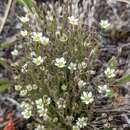pt-BR
nomes no trilho de navegação


Deugotyledon ac un o deulu'r 'pincs' fel y'u gelwir ar lafar gwlad yw Tywodlys bach coch sy'n enw gwrywaidd. Mae'n perthyn i'r teulu Caryophyllaceae. Yr enw gwyddonol (Lladin) yw Minuartia rubella a'r enw Saesneg yw Mountain sandwort.[1] Ceir enwau Cymraeg eraill ar y planhigyn hwn gan gynnwys Tywodlys Bach Coch, Tywodwlydd Bychan Coch.
Caiff ei dyfu'n aml mewn gerddi oherwydd lliw'r planhigyn hwn. Mae'r dail wedi'i gosod gyferbyn a'i gilydd.
Deugotyledon ac un o deulu'r 'pincs' fel y'u gelwir ar lafar gwlad yw Tywodlys bach coch sy'n enw gwrywaidd. Mae'n perthyn i'r teulu Caryophyllaceae. Yr enw gwyddonol (Lladin) yw Minuartia rubella a'r enw Saesneg yw Mountain sandwort. Ceir enwau Cymraeg eraill ar y planhigyn hwn gan gynnwys Tywodlys Bach Coch, Tywodwlydd Bychan Coch.
Caiff ei dyfu'n aml mewn gerddi oherwydd lliw'r planhigyn hwn. Mae'r dail wedi'i gosod gyferbyn a'i gilydd.
Minuartia rubella is a species of flowering plant in the family Caryophyllaceae known by several common names, including beautiful sandwort,[1] mountain sandwort,[2] Arctic sandwort, and boreal stitchwort. It has a circumboreal distribution, occurring throughout the northernmost Northern Hemisphere from the Arctic Circle on the Arctic tundra into the alpine climates of mountainous areas in temperate Eurasia and North America. It grows in rocky, moist, often barren habitat, including gravelly, sparsely vegetated slopes with little organic matter.[3] It is a calciphile, growing in calcareous substrates such as soils rich in decomposed limestone.[4]
This is a small, mat-forming perennial herb growing in a low, tight clump of hairy, glandular herbage. The green, three-veined leaves are needlelike or flattened, no more than a centimeter long and a millimeter wide. The plant blooms in summer with tiny flowers made up of pointed sepals under 4 millimeters long and five white petals roughly the same length or slightly smaller.
Minuartia rubella is a species of flowering plant in the family Caryophyllaceae known by several common names, including beautiful sandwort, mountain sandwort, Arctic sandwort, and boreal stitchwort. It has a circumboreal distribution, occurring throughout the northernmost Northern Hemisphere from the Arctic Circle on the Arctic tundra into the alpine climates of mountainous areas in temperate Eurasia and North America. It grows in rocky, moist, often barren habitat, including gravelly, sparsely vegetated slopes with little organic matter. It is a calciphile, growing in calcareous substrates such as soils rich in decomposed limestone.
This is a small, mat-forming perennial herb growing in a low, tight clump of hairy, glandular herbage. The green, three-veined leaves are needlelike or flattened, no more than a centimeter long and a millimeter wide. The plant blooms in summer with tiny flowers made up of pointed sepals under 4 millimeters long and five white petals roughly the same length or slightly smaller.
Minuartia rubella (l'Alsine rougeâtre ou la Minuartie rougeâtre) est une espèce végétale alpine vivace de la famille des Caryophyllaceae.
Petite plante en touffe formant des coussins. Feuilles de 4 à 8 mm. Fleurs de 5 à 8 mm, solitaires, pétales plus courts que les sépales.
Juin à août.
Rochers alcalins de montagnes jusqu'à 1 200 m.
Minuartia rubella (l'Alsine rougeâtre ou la Minuartie rougeâtre) est une espèce végétale alpine vivace de la famille des Caryophyllaceae.